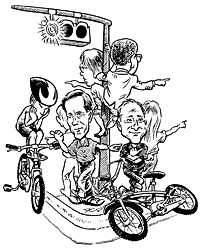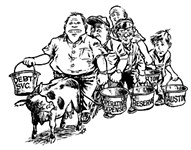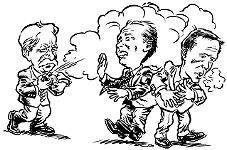Mixed Signals
Council Navigates Transportation Matters
By Kayte VanScoy, Fri., April 3, 1998
|
|
First there was wrangling between a neighborhood association and the city planners over widening the intersection of North Loop and Burnet Road. Then there was the little question of turning several downtown streets into two-way thoroughfares. Next, the council tackled the city's bicycle plan, and finally it turned to the creation of a rail authority between Austin and San Antonio. And those were just the thorniest issues. All in all, the meeting was an exhaustive attempt to tackle the most arduous issues on the city's transportation plate; we can only hope that the council hasn't bitten off more than it can chew.
The debate over the North Loop/Burnet intersection is a framework of the classic problems faced in Austin's growth. The competing visions of the neighborhood and city planners hinge on the question of what purpose the intersection serves. Is it primarily a neighborhood intersection, in need of added landscaping and other pedestrian-friendly improvements? Or is it a bottle-necked arterial crying out for enhancements to traffic flow? The answer here, as it is in so many mixed-use areas of town, unfortunately, is both. So it falls to the council to puzzle through the competing interests and prioritize funding for improvements.
The rote engineering answer to increasing traffic at the intersection is to add dedicated left-turn lanes to all four corners on Burnet and North Loop. But Brentwood neighborhood activist Clare Barry worries that people will avoid the intersection if the extra 10 feet of pavement is added to each crossing. Arguing to the council that the difference the 10 feet would make was "intuitive and not statistical," Barry went on to express her frustration. "The issue is whether the neighborhood can make its own decision. It seems to be our position against your staff's position," she said. Mayor Kirk Watson was not swayed. "I'm not willing to spend the money unless I see that it improves traffic flow," he said, effectively placing the burden of proof for such a litmus test in Barry's lap.
The issue broke the council down the middle, with Councilmembers Jackie Goodman and Beverly Griffith strongly in support of Barry's proposal for added pedestrian improvements, and Watson and Daryl Slusher supporting the staff's car-friendly plan. Bill Spelman and Willie Lewis were floating somewhere around the middle, but without Gus Garcia present to assure a tie-breaking 4-3 vote in one direction or another, the council decided to postpone the decision for two weeks.
After the postponement, Barry, a personal friend of Watson and Slusher, was ready to vent. "This is just Daryl [Slusher] and Kirk [Watson] sticking with their transportation way of thinking. The traffic engineers we're paying for with our tax dollars have a totally different philosophy of transportation than we do," she said, bemoaning her limited resources and time to fight with the council on behalf of the neighborhood. "The staff is always going to look better than me," she observed.
Public Works director Peter Rieck calls Barry's plan "more of a beautification project than a project that truly provides for better mobility," and agrees with Watson that the funds would better be spent at some other troubled intersection than on aesthetics. In any case, the city staff has already, without council's direction, stacked the deck in its favor by buying $319,266 of right of way from the businesses at Burnet and North Loop in preparation for the road expansion, and it isn't likely that council will let that investment go to waste.
So, where were our Green Champions to back up Barry against the big, bad, city staff? Well, in Slusher's case, he was busy raking the new bike plan and bike coordinator, Keith Snodgrass, over the coals. Without committing funding to the bike plan, Slusher made Snodgrass prove to him that it was even worth it to adopt such a plan. Snodgrass reminded Slusher that without some sort of plan in place, the Austin Transportation Authority would make unilateral planning decisions for the city.
Slusher continued, inviting Rieck to attack the plan. "There were parts of the sidewalk plan that your department doesn't favor. Do you have problems with the bike plan?" Slusher asked eagerly. Rieck said he didn't. Slusher worried aloud about having just one more plan on the shelf gathering dust, despite the fact that the decision to fund and back up such plans falls to him and the rest of the council. Slusher did not return phone calls for this article.
At any rate, a public hearing on the bike plan will be held some time in April and, in the meantime, the city manager's office is reviewing the proposal to determine how council can swing the financial end of the deal.
Two-Way Streets
Where there might have been hesitation backing up the cries of neighborhood residents and bicycle activists, the council had no trouble mustering its support for the Downtown Austin Alliance's (DAA) plan to make several downtown streets into two-way thoroughfares. Brazos, Colorado, Fifth, Sixth, and Cesar Chavez Streets were all approved for two-wayness last Wednesday to improve and slow traffic flow in and out of the booming downtown. Pedestrians and cyclists are also figured into this plan, with the theory being that slower traffic will make it easier for them to navigate the streets. Lucy Buck, DAA president, was slightly disappointed that Brazos and Colorado are going to be addressed first since they are "low-traffic, low-cost, low-disruption. But that also means [the improvements] will be kind of low-impact," she added. Nevertheless, Buck can hardly complain, since she and the business owners she represents at least have a willing ear with the council.
Another foot-friendly proposal would implement traffic-calming measures on Barton Springs Road in the Zilker Park area. Possibilities here would include a traffic circle, sidewalks and a median - all of which council is scheduled to address April 9.
The real word on Austin's transportation strategy will come when we see how the council eventually decides to spend its money. Currently, only $427,030, or 1% of the city's transportation dollars, are devoted to bicycles. "What it eventually all boils down to is how these priorities are going to be looked at during the budget process and how council wants to deal with funding goals. Based on current funding levels, very little can be achieved on the bike or pedestrian side," admits Rieck.
DJCC Wins
In a decision met with equal parts tears and cheers, the city council last week finally broke the stalemate between the proposed Dell Jewish Community Center (DJCC) at Hart Lane and Far West Boulevard, and several Northwest neighborhoods. The DJCC came before council as an appeal from the Planning Commission's approval of a conditional overlay which would have allowed overlapping zoning uses, from recreational facilities to worship centers, and much higher density than the site's current multi-family zoning would allow. Although neighborhood leaders say they welcomed the center in principle, they opposed the DJCC-generated increase in traffic, noise, and glare from lighted ballfields.
Jewish community leaders, however, threatened to move the site into the suburban hinterlands if significant changes were made to their plans. Not wanting to lose the considerable investment in centralized infill, and also vexed by the delicate balance of religious issues surrounding the debate, the city council was reluctant to rally behind the neighborhood in its downsizing campaign. The final result was a little less than the win-win it was touted to be, and in fact little more than a total defeat for the neighborhood's position.
Although DJCC's side agreed to allow the construction of the project to be phased to monitor traffic as the density increases, the neighborhood lost ground on almost every other point. A proposed entrance from a small neighborhood street will still be built, with access nixed only before 8:30am. Ballfields will be lit until 9:30pm. But most significantly, the size of the three largest features on the site - the tabernacle, the temple, and the community center - all remained intact, so the projected increase of between 4,000 and 6,000 vehicle trips a day was not curtailed. "The council didn't feel they could impose downsizing when the applicant didn't want to," said Councilmember Bill Spelman, who brokered the agreement between the two parties. Calling this the hardest zoning case the council has tackled since he took office in June, Spelman admitted that council made concessions to DJCC. "If we were judges and had to make a judgment based on the law, it's easy to argue that this project just had to be turned down because, yeah, it generated more traffic than [the zoning] would allow," he said. "We had to make it possible for them to build it someplace."
This Week in Council: No meeting this Thursday, April 2.
Got something to say on the subject? Send a letter to the editor.









